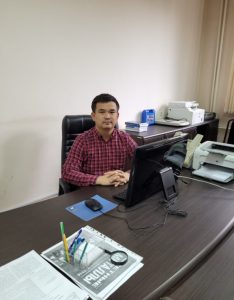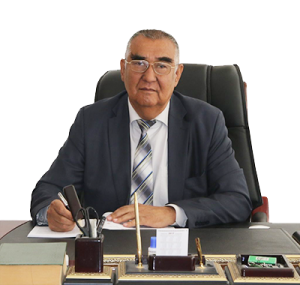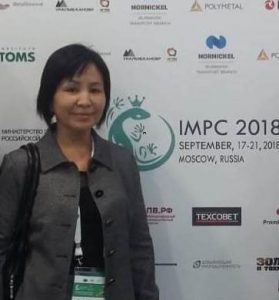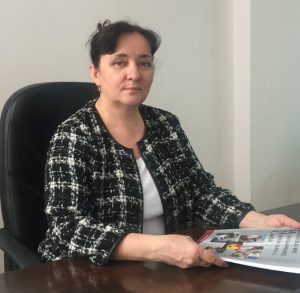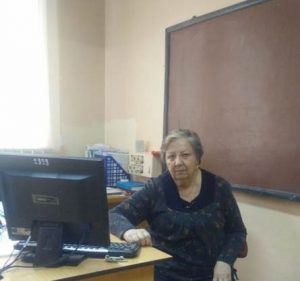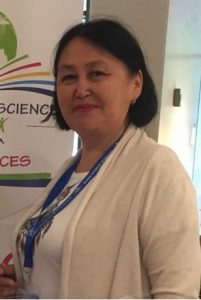AP14869407
Development of an integrated and waste-free technology intended to process technogenic raw materials received from copper production.
Project Manager: Kvyatkovskiy S.A.
Relevance: Problems that the project aims to study are to determine the conditions to implement sintering of man-made materials, hydrothermal treatment of sinter, acid extraction of antimony, selenium, tellurium from sulfide-alkaline solutions, cake melting. Scientific novelty is determined by studying the phase formation regularities of non-ferrous metal thiosalts, the solubility of thiosalts in sulfide-alkaline solutions of various concentrations, acid decomposition of the sulfide-alkaline solution with the separation of sulfides of antimony, rare metals and arsenic. Main research approaches are determined by the establishment of the temperature regime of the processes, the composition of the charges and products, concentration of solutions. Man-made materials received from copper production, in particular, smelting slags of the noble metal production of the Balkhash copper smelter are complex and refractory, containing various compounds of heavy, noble, rare metals, as well as toxic components (arsenic). The metallurgy of thiosalts has unique opportunities for extraction of complex raw materials with the separation of non-ferrous metals into products. The proposed technology includes the main operations, i.e. sintering and hydrothermal treatment of the sinter with the transfer of part of the thiosalts into a sulfide-alkaline solution. Heavy and noble metals pass into the cake due to the decomposition of unstable thio compounds. The cake is subjected to electrothermal melting to obtain black lead and noble metals dissolved in it. The study results on the theory of metallurgy of thiosalts will improve the quality of the personnel potential of study institutes through the acquisition of new, previously unstudied, reference materials that will increase the competitiveness, complexity, non-wastefulness, economic efficiency metallurgical industry of the Republic of Kazakhstan
Project goal:Creation of an integrated and waste-free technology in to process man-made raw materials received from copper production based on the metallurgy of thiosalts.
Objectives of the project:
Objectives of the project:
1) Studies of the effect of technological conditions for sintering on the formation of non-ferrous metal thiosalts.
2) Study of technological conditions for hydrothermal treatment of sinter, electrothermal melting of cakes, decomposition of sulfide-alkaline solutions.
3) Development of technological conditions for the design of equipment for processing of man-made materials received from copper production.
Expected results:
- the effect of technological conditions of sintering on the formation of non-ferrous metal thiosalts will be studied;
- the technological conditions for hydrothermal treatment of sinter, electrothermal melting of cakes, decomposition of sulfide-alkaline solutions will be studied;
- technological conditions developed for the design of equipment of technogenic materials received from copper production will be a result of the study.
An integrated and waste-free technology intended to process man-made materials received from copper production will be created based on theoretical studies of thiosalt metallurgy as a result of the project implementation.
3 articles and (or) reviews will be published in peer-reviewed scientific journals indexed in the Science Citation Index Expanded Web of Science and (or) have a CiteScore percentile in the Scopus database of at least 35, as well as 1 article or review in a peer-reviewed foreign or domestic edition recommended by Committee for Quality Assurance in the Sphere of Education and Science of the Ministry of Education and Science of the Rebublic of Kazakhstan (CQASES) based on the study results.
AP14869208
Development of a resource-saving waste-free hydrometallurgical technology for processing the kaolinite fraction of gibbsite-kaolinite bauxites with preliminary autoclave thermochemical transformation of the phase composition.
Project Manager: Gladyshev S.V.
Relevance:Alumina production is based mainly on the processing of high-quality bauxite by the Bayer method. This method involves the use of bauxites with a silicon module above 7. The absence of high–quality alumina–containing raw materials in Kazakhstan makes it necessary to involve in the processing of low-quality gibbsite - kaolinite bauxites with a silicon module 3-4. Rational processing of which is possible only after enrichment by separating the clay - kaolinite fraction of bauxites, since its processing for the extraction of alumina is associated with the need to use an energy-intensive sintering method or acid technology.
Project goal:Development of a resource-saving waste-free hydrometallurgical technology to process the kaolinite fraction of gibbsite-kaolinite bauxites with preliminary autoclave thermochemical transformation of the phase composition.
Objectives of the project:
1.Study of the mechanisms of autoclave thermochemical transformation of the kaolinite fraction of gibbsite-kaolinite bauxites of the Krasnogorsk deposit, alkaline opening with the active addition of calcium sulfate form and regeneration of the leaching solution.
2. Development of waste-free. integrated. alkaline hydrometallurgical technology to process kaolinite fraction after preliminary autoclave thermochemical transformation to obtain alumina and silicate products.
3. Conducting integrated laboratory tests, calculating the Material Balance, issuing initial data for the development of the Technological Regulations to process the kaolinite fraction of gibbsite-kaolinite bauxites of the Krasnogorsk deposit and assessing the technical and economic efficiency of production.
Expected results:
- the mechanisms of autoclave thermochemical transformation of the kaolinite fraction of gibbsite-kaolinite bauxites of the Krasnogorsk deposit, alkaline opening with the active addition of calcium sulfate form and regeneration of the leaching solution will be studied;
- a waste-free, integrated. alkaline hydrometallurgical technology to process kaolinite fraction will be developed after preliminary autoclave thermochemical transformation to obtain alumina and silicate products;
- enlarged laboratory tests will be performed, the Material Balance will be calculated. initial data will be issued for the development of the Technological Regulations to process the kaolinite fraction of gibbsite-kaolinite bauxites of the Krasnogorsk deposit and assessment of the technical and economic efficiency of production;
-4 (four) articles published: 3 (three) articles and (or) reviews will be published in peer-reviewed scientific journals indexed in the Science Citation Index Expanded of the Web of Science database and (or) have a CiteScore percentile in the Scopus database of at least 35 (thirty-five), 1 (one) article and (or) review in a peer-reviewed foreign or domestic publication recommended by Committee for Quality Assurance in the Field of education and Science of the Ministry of Education and Science of the Republic of Kazakhstan based on the research results.
AP14869944
Study of the thermodynamics of formation and evaporation of antimony alloys with chalcogens under conditions of vacuum-distillation processing of polymetallic mattes
Project Manager: Volodin V.N.
Relevance:In distillation technologies, the problem of isolation and separation of chalcogens and chalcogenides rare elements is one of the topical. The prerequisites for the development of the Project were the lack of fundamental research on the physical and chemical properties of chalcogens and chalcogenides rare metals, in particular, Te, Se, Sb2Te3, Sb2Se3, Sb2S3 in matte systems and information about their behavior during the processing of polymetallic melts. Information about them and their properties in the literature is rare or completely absent, and their behavior at high temperatures is practically not studied. One of the significant factors that distinguishes the idea of the project from existing analogues is the concentration of rare metals in one middling product that significantly reduces the scheme for extracting them in elemental form. When the project is implemented scientific research is required on the development of physical and chemical foundations aimed at studying the thermodynamics of binary systems of chalcogens with antimony, and an original approach to developing new ideas about physical and chemical processes at the phase boundary, with plotted boundaries of the fields of coexistence of liquid and vapor at atmospheric pressure. pressure and in vacuum that are currently absent and allow one to judge the possibility and completeness of the separation and separation of elements, the number of technological cycles, the composition of the condensate and distillation residue, reducing energy costs, etc. The absence of these significantly hinders the creation of effective vacuum distillation technologies extraction of rare metals from polymetallic raw materials. Therefore, from a technological point of view, the need for this project is to issue recommendations that can be used in the development of highly efficient distillation technologies for the extraction of antimony, selenium and tellurium by both domestic and foreign developers. The studies planned within the framework of the project are unique, since similar work is not performed in the near and far abroad. It ensures the novelty and competitiveness of research on an international scale and provides new opportunities to solve technological problems in the distillation recovery of rare metals from mattes.
Project goal: Obtaining the thermodynamic constants of the condensed and vapor phases of binary systems of antimony with tellurium, selenium and sulfur, as well as constructing liquid-vapor phase transitions at atmospheric and low pressures enabling to track the behavior of these rare elements under the conditions of vacuum distillation processing of mattes.
Objectives of the project:
The study of the vapor-liquid equilibrium of molten systems is hampered by the high boiling point of solutions and aggressiveness in relation to structural materials, as well as the difficulty in determining the concentration of components in the vapor phase that is in equilibrium with the melt. In this regard, the following tasks will be solved during the implementation of the project:
Objective 1. The choice of a method intended to determine the vapor pressure of components and conducting experiments to determine the vapor pressure of the components of the antimony-tellurium system.
Objective 2. Determination of the boundaries of the coexistence of melt and vapor and thermodynamic functions in the antimony-tellurium system. Study of the thermodynamics of the system antimony - selenium with the correction of the state diagram.
Objective 3. Study of the thermodynamics of the antimony - sulfur system with the correction of the phase diagram and the determination of the thermodynamic constants of the condensed and vapor phases and antimony sesquisulfide.
Expected results:
Expected results. When the tasks set are fulfilled, complete diagrams of the state of antimony with tellurium, selenium and sulfur will be completed, including three aggregate states of the substance, on the basis of which one can judge the distribution and the possibility of extracting rare elements into a separate middling product or the absence of such, and technological recommendations for the extraction of rare metals. 1) The results of scientific research obtained during the implementation of the project are planned to be published at least 3 (three) articles and (or) reviews in peer-reviewed scientific publications in the scientific direction of the project, included in 1 (first), 2 (second) and (or) 3 (third) quartile by impact factor in the Web of Science database and (or) having a CiteScore percentile in the Scopus database of at least 50 (fifty), as well as 1 (one) article in a peer-reviewed foreign or domestic publication with a non-zero impact factor recommended by COXON.
AP14869579
Development and testing of alkali-sulfate technology for processing nepheline syenites of the Kubasadyr deposit
Project Manager: Akhmadieva N.K.
Relevance:The problem that the project aims to solve: Currently, there is no effective technology for processing nepheline ores. High energy intensity, capital intensity and significant emissions into the atmosphere are the main disadvantages of the generally accepted technology of processing nepheline ores by sintering. In the project, to solve the problem of processing nephelins, based on the technical solutions adopted, the possibility of using a new alkaline-sulfate hydrochemical technology for the extraction of alumina is being considered. The relevance of the research is determined by the problem of limited reserves of high–quality – Bayer bauxite in the production of alumina in Kazakhstan, which determines the urgent need for the possibility of using non-bauxite raw materials - nephelins. Due to the limited reserves of Bayer bauxite in the sphere of industrial production of alumina in Kazakhstan, it is possible to use alternative alumina-containing non-bauxite raw materials. This circumstance is the basis for carrying out a complex of theoretical and technological research to develop an effective technology for processing nepheline syenites. The scientific novelty of the proposed work is the hydrochemical alkali–sulfate technology for the complex processing of nepheline syenites, including preliminary chemical enrichment and leaching using a new active calcium additive. The results of the research will make an additional contribution to the theory of hydrometallurgical processes and can be used to develop the theory of heterogeneous phase equilibria in aluminosilicate systems The main approaches used in the project research The project's research for the first time covers the creation of a new technology in which the mechanism and patterns of interaction of alkaline solutions with components of nepheline ore and an innovative calcium additive are established.
Project goal:Development and testing of alkaline-sulphate technology for processing nepheline syenites of the Kubasadyr deposit.
Objectives of the project:
1) Study of the material and chemical composition of nepheline syenites of the Kubasadyr deposit. Choice of optimum parameters of chemical enrichment. Investigation of the effect of pre-calcination and chemical activation on the beneficiation process. The material and chemical composition of nepheline syenites of the Kubasadyr deposit will be studied, the optimal parameters of chemical enrichment will be selected, and the influence of pre-calcination and chemical activation on the enrichment process will be studied. The results obtained during the implementation of the first task are necessary for conducting research on the development of technological parameters for the complex processing of nepheline syenites using the alkaline-sulphate leaching method.
2) Study of the mechanism of the alkaline-sulphate leaching of nepheline syenites. Development of technological parameters for leaching of nepheline syenites and regeneration of circulating solutions. The mechanism of the alkali-sulphate method will be investigated and the technological parameters of the leaching of nepheline syenites and the regeneration of circulating solutions will be worked out. A representative sample of nepheline syenites from the Kubasadyr deposit will be used as a raw material. The results obtained during the execution of the second task are necessary for calculating the Material Balance and preparing the initial data for the Technological Regulations.
3) Carrying out integrated laboratory tests. Calculation of the Material Balance and preparation of initial data for the Technological Regulations. Conducting an assessment of the technical and economic efficiency of production. Large-scale laboratory tests will be carried out. The Material Balance will be calculated and the initial data for the Technological Regulations will be prepared and an assessment of the technical and economic efficiency of production will be carried out.
Expected results:
According to the results of the research will be:
- the material and chemical compositions of nepheline syenites of the Kubasadyr deposit were investigated, the optimal parameters of chemical enrichment were selected, the effect of preliminary roasting and chemical activation on the enrichment process was investigated;
- the mechanism of the alkaline-sulfate method of leaching of nepheline syenites was studied, the technological parameters of leaching of nepheline syenites and regeneration of circulating solutions were worked out;
- integrated laboratory tests were carried out, the Material Balance was calculated and the initial data for the Technological Regulations were prepared;
- an assessment of the technical and economic efficiency of production was carried out;
- 3 (three) articles and (or) reviews have been published in peer-reviewed scientific journals indexed in the Science Citation Index Expanded of the Web of Science database and (or) with a CiteScore percentile in the Scopus database of at least 35 (thirty-five); 1 article in a domestic journal with a non-zero impact factor (recommended by the CQAES).












